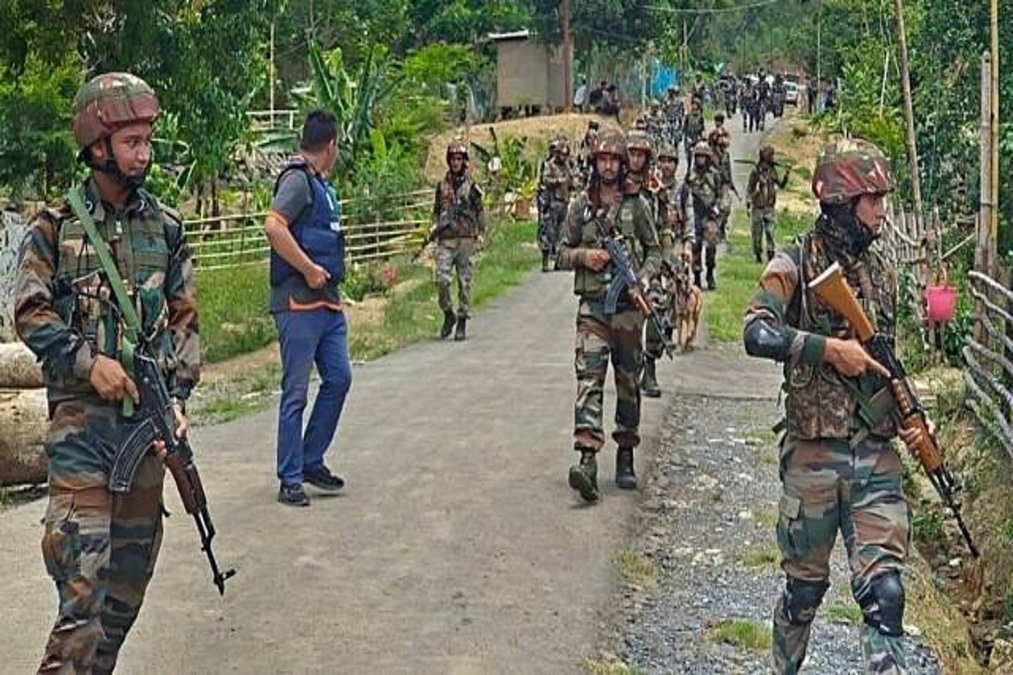Understanding the Recent Attack in Manipur: An In-Depth Look at Security and Ethnic Tensions
On November 11, 2024, a Kuki militant attack in Thamnapokpi, Manipur, led to the injury of a soldier from the Mahar Regiment. The attack ignited a fierce gunfight between militants and security forces. Despite injuries, the Indian Army successfully countered the assault. The incident underscores rising tensions in the region, prompting officials to assess security strategies and support stability efforts amid ongoing ethnic conflicts.
Introduction: The Rising Tensions in Manipur
Manipur, nestled in India’s northeastern region, is home to a rich blend of cultures and communities. But with this diversity come conflicts, often deeply rooted in ethnic and territorial differences. The recent attack in Thamnapokpi by Kuki militants shines a light on these tensions, raising questions about security, peace, and the future of the region. So, what does this attack tell us about the current situation, and what lies ahead for Manipur?
A Brief History of Manipur’s Ethnic Landscape
Manipur’s ethnic makeup has historically been a point of pride and contention. The Kukis, Nagas, and Meitei communities each hold a distinct place in the region’s fabric, with unique languages, customs, and governance. However, years of unresolved disputes over territory, autonomy, and political representation have often led to clashes.
The Thamnapokpi Incident: A Close Look at What Happened
In the early hours of November 11, Kuki militants targeted a security post at Thamnapokpi, triggering a gunfight with stationed soldiers. While initial reports confirmed the injury of one army personnel, swift action by the Indian Army prevented further casualties and reinforced the area’s security. But why Thamnapokpi? Its strategic importance and location within a hotspot of ethnic divides make it a frequent focal point of unrest.
Understanding the Kuki Militants: Who They Are and What They Want
The Kuki community has long voiced concerns over autonomy and cultural preservation. Over time, these demands have fueled the formation of various militant groups advocating for the Kukis’ interests. This includes calls for greater territorial control and self-governance, which they believe are crucial for preserving their identity. However, these demands often lead to clashes with the government and other ethnic groups, particularly over land and resources.
The Role of Security Forces in Maintaining Peace
The Indian Army and other security forces in Manipur play a critical role in maintaining stability. Deployed across conflict-prone zones, they face the challenging task of securing the area while addressing local grievances. The incident at Thamnapokpi underscores the need for a robust military presence. It also raises questions about how best to manage these confrontations in a way that prioritizes peace without sacrificing the safety of locals or personnel.
Why Thamnapokpi Is a Strategic Hotspot
Thamnapokpi’s location makes it a point of interest for both the military and militant groups. As an access point to various Kuki strongholds and a transit route, control over this area gives any group significant leverage. This geography is precisely why the Indian Army places a strong focus on Thamnapokpi, recognizing its importance in curbing militant activities.
The Government’s Response: Evaluating Security Protocols and Future Strategies
Following the incident, local and central government representatives convened to discuss strengthening security measures. This response emphasizes both preventive strategies, such as increased intelligence and monitoring, and reactive measures to ensure that any future attacks are countered swiftly. While the presence of security forces is reassuring, authorities recognize the need to address underlying issues to prevent these tensions from escalating further.
Impacts on Local Communities
For the people of Manipur, ongoing violence creates a climate of fear. Simple tasks like commuting or running a business are overshadowed by the risk of being caught in crossfire. Beyond the immediate physical threat, the conflict impacts economic development, education, and mental well-being. Restoring peace would go a long way toward helping these communities regain a sense of normalcy.
Steps Toward Resolution: Can Peace Be Achieved?
Is peace in Manipur attainable? The solution isn’t simple, but various pathways could make a difference:
- Dialogue and Diplomacy: Engaging with Kuki leaders and other ethnic representatives in open, structured dialogues could bridge misunderstandings and foster compromise.
- Empowering Local Governance: Allowing local authorities more autonomy to address their specific needs may reduce the appeal of militant activities, providing a constructive outlet for grievances.
- Military Reinforcements and Training: Enhancing the skillset of stationed forces with region-specific training can help them respond more effectively to the unique challenges posed by local conflicts.
- Community Development Programs: Economic incentives and development projects could create opportunities, reducing recruitment into militant factions by offering alternative means of livelihood.
Challenges in Bringing Lasting Peace
Manipur’s peace efforts face a multitude of challenges, from deep-rooted ethnic divides to difficult terrain that makes conflict zones hard to monitor. Here are some specific obstacles that peace efforts need to address:
- Ethnic Fragmentation: With each ethnic group seeking representation, creating policies that satisfy everyone is challenging. Historical grievances often fuel distrust among communities, complicating reconciliation.
- Geographical Limitations: Manipur’s mountainous and forested landscapes hinder rapid military response, allowing militant groups to evade capture.
- Outside Influence: The involvement of external actors sometimes provides resources or incentives for local militant factions, making the conflict harder to resolve.
- Public Sentiment and Mistrust: For local residents, the presence of armed forces can sometimes feel intrusive, which hinders collaboration between communities and the government.
Why Stability Is Essential for Progress in Manipur
Beyond safety, peace is crucial for the state’s progress. Stability would attract investments, create job opportunities, and enhance infrastructure. When businesses can operate without disruption, education systems flourish, and locals can access resources more freely. Economic growth is inextricably linked to peace, making it a high priority for everyone involved.
Conclusion: What’s Next for Manipur?
While challenges remain, Manipur’s future depends on a balanced approach that includes both strong security measures and community-focused policies. Progress will require persistence, compassion, and a commitment to dialogue. For Manipur, peace isn’t just a distant dream—it’s an achievable goal if all parties commit to a path of mutual respect and understanding.
FAQs
- What was the reason behind the Kuki militant attack on Thamnapokpi?
- Thamnapokpi holds strategic value due to its location, making it a focal point for Kuki militants aiming to assert influence and challenge government control.
- How has the Indian Army responded to the attack?
- The Army quickly engaged the militants in a gunfight, and government officials have since met to discuss enhanced security measures in the area.
- What drives the conflict between the Kuki militants and the government?
- Long-standing ethnic and territorial disputes, along with demands for greater autonomy, drive much of the conflict between the Kuki militants and state authorities.
- How do these conflicts affect the people of Manipur?
- The ongoing violence impacts daily life, limiting economic opportunities, affecting education, and creating an environment of fear and insecurity for local residents.
- What are the possible solutions to bring peace in Manipur?
- Possible solutions include structured dialogues, local governance empowerment, increased military training, and community development initiatives to address the root causes of the conflict.





